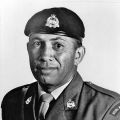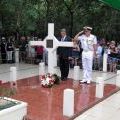
Commemoration ceremony and dedication of memorial cross on the site of the Battle of Long Tan (Noel Bell)
Every veteran has a defining memory of their time on operations – a particular firefight, a near miss, a comrade killed in action. V3 veteran Bruce Goodall recalls: “The trouble with contacts is the first one's great. Second one not so bad. Third one you know what's going to happen. Fourth one you're starting to shit yourself. You start getting very wary, particularly when it's coming time to get out.” The war in Vietnam was fought at close range in jungle terrain negotiated inch by inch, the ever-shifting ‘front line’ and elusive enemy made for tentative soldiering and little downtime on operations. While the war was ultimately lost by the allied coalition, the objective to seize the initiative in the Phuoc Tuy province was largely achieved, with provincial enemy forces rendered largely ineffective without outside support. [1]
Battle of Long Tan
On 18 August 1966, D Company of 6RAR set out on a sweep through an area from which VC forces had bombarded the 1ATF base at Nui Dat two days before. In the Long Tan rubber plantation five kilometres east of Nui Dat they encountered a combined North Vietnamese Army (NVA) and Viet Cong (VC) force estimated at 1500-2000 strong. Their task was made more difficult by an extraordinary storm that began early in the engagement. During the ensuing battle, D Company held off repeated attacks, with artillery support from 161 Battery and three other batteries at Nui Dat. Pinned down in the rubber plantation with D Company, a New Zealand artillery forward observer (FO) party – Captain Maurice Stanley, Lance-Bombardier Murray Broomhall, and Lance Corporal Willie Walker – helped direct devastating artillery fire on the enemy forces.
Tet Offensive
Early in the morning of 31 January 1968, North Vietnamese Army and Viet Cong forces attacked around a hundred towns and cities in South Vietnam, breaking the Tet ceasefire tacitly agreed for the lunar New Year. The size and ferocity of the attack surprised the Americans and South Vietnamese but they regrouped and fought back. The communists, who had hoped for a popular uprising in support of their actions, instead met heavy resistance. While Whisky Company remained at the Horseshoe, Victor 2 Company took part in Operation Coburg in Bien Hoa province. For the New Zealand gunners Tet was a busy period – they fired some 6000 rounds and survived three enemy attacks against Fire Support Base (FSB) Anderson, 27 kilometres north-east of Bien Hoa. [2]
Attack on Fire Support Base Coral
FSB Coral was established by 1ATF north of Bien Hoa City to intercept and disrupt the approach of enemy forces towards Saigon and the large United States air base at Bien Hoa. On 12 May 1968, Coral was occupied by troops of 1RAR along with 102 Field Battery, RAA and 161 Battery, RNZA. Before an adequate defensive perimeter had been established, a North Vietnamese Army regiment attacked Coral. Fighting was intense and Viet Cong troops took over part of the firebase before being pushed back with assistance from 161 Battery.
[1] Roberto Rabel, 'The ANZAC Battalion - NZ and the Vietnam War', 2000, URL: http://www.nzhistory.net.nz/war/vietnam-war/anzac-battalion, accessed 13 April 2013
[2] Ian McGibbon, New Zealand’s Vietnam War, Exisle, Auckland, 2010, p. 203
- War's End - PoemPoem written on the 30th anniversary of the fall of South Vietnam.Read more...
- Australian Military Forces PocketbookAustralian Military Forces Pocketbook on South Vietnam used by Gunner Ken Deacon, 1965-1966. Read more...
- Leadership - Wayne RobsonDuring the battle at Long Tan I was busily trying to get myself below ground level by trying to dRead more...
- Memories of Viet Nam - Wayne RobsonOn 27 May 1965, the New Zealand Government, after a great deal of anguish and hand wringing, annoRead more...















